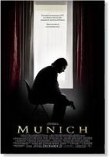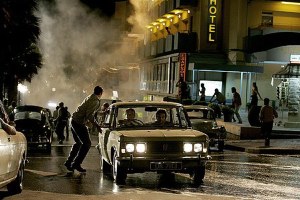 Chapters
Steven Spielberg, Tony Kushner, Eric Bana, Daniel Craig, Geoffrey Rush, Azelet Surer, and more.
Slaughter during Olympic Games and follow-up Operation Wrath of God.
Steven Spielberg explores a definitive moment in history.
Steven Spielberg brings Pulitzer Prize-winning Tony Kushner.
Global cadre of 200 actors joins the production.
Steven Spielberg and Janusz Kaminski update gritty '70s thriller.
Bringing a hidden world to light in Malta, Hungary.
Ain't No Sunshine, Papa Was A Rollin' Stone, Ela-Ela, Black Magic Woman, Prelude To A Kiss, Palamakia, and more.
|
The story of Munich unfolds in three separate realms: the extremely public events of the Munich Olympics which took place under the glare of the international media, the extremely secretive and shadow-laden world of the Mossad and its unacknowledged hit squads operating around the world under an opaque cloak, and the internal worlds of the five diverse assassins themselves as they take on the psychological twists and turns of their unprecedented assignment.
To capture all of this visually, Steven Spielberg turned to one of his longtime trusted collaborators, the two-time Academy Award®-winning cinematographer Janusz Kaminski, who has worked with Spielberg on nine previous films. A Polish teenager in 1972, Kaminski watched the events of Munich from a somewhat different perspective-through the veil of the Iron Curtain. “In Poland it was seen of course as a tragic event, as it was all over the world,” he says, “but the news that we got through official sources indicated a certain bias.”
Yet the cinematographer believes that one of the most fascinating elements of turning the events surrounding Munich into a motion picture is that nearly everybody has both a uniquely personal memory of it. “We all have our own experience with this event,” he says. “Even if you weren't born yet, you've seen bits of it on television or in history books. Or you've been introduced to it through recent events. But whichever way you come at it, it is very relevant.”
Working in the usual manner of their unique collaboration, Kaminski's initial action was to shoot a series of photographic tests to find a look that he and Spielberg felt suited the intense mood and suspenseful structure of the film-one that they hoped would echo some of the classic paranoid thrillers of the '70s but with a contemporary edge.
“Steven and I are at a point in our relationship right now that we have to discuss things very little,” Kaminski notes. “He knows and trusts my judgment and I know his aesthetic sense very well. We converse a little, mostly about what we really shouldn't do, but pretty much the visual style is left for me to determine. So I went to Paris in 2004 and started experimenting with various color schemes, various filters, various lenses, various lighting and various chemical processes.”
In further developing the film's visual style, Kaminski looked at the story through the prism of a world map. “There are 8 different countries in the film, and I decided to give each a different look, very subtly, and each with a somewhat different color palette. This way each country has its own individuality, even though most of them were shot in Malta and Hungary,” he says. “So everything that happens in the Middle East is more colorful, warmer, sunnier. But once we leave that part of the world for Paris, Frankfurt, London and Rome the colors become cooler and more de-saturated. And even each of those European cities each have their own character and colors.”
For example, Kaminski points out that for the scenes in Cyprus he emphasizes more vibrant, sun-baked yellow tones, while in Athens the color palette veers towards Aegean blues, and then in Paris, the palette becomes much softer with an ambience of rainy skies. The lighting also shifts in the film, starting with a friendlier tone as the hit squad first gets to know one another at an intimate dinner and moving to a harsher photo-chemical process full of darker shadows that reflect the characters' inner turmoil as their mission becomes more frightening and filled with doubts.
Each one of the assassinations is also shot in a unique manner, which is how Spielberg envisioned the film unfolding. “I wanted every assassination to be different, because as the team experiences each one, their views about what they're doing change, the group dynamics shift, they change their feelings about themselves and each other, and there's more and more stress, anxiety and pressure,” Spielberg explains. “So each of the missions has its own personal character.”
The choice of lenses was influenced by Spielberg's desire to hearken back to a grittier, '70s style of filmmaking. “Steven insisted, rightfully, that we use zoom lenses,” Kaminski notes. “He felt that '70s cinema was so full of zooms that if you start zooming in and out you're allowing the viewers to feel like they're watching a film made in that time. It's a very effective way of creating the sense of period.” Kaminski cites such realistic thrillers as The French Connection, Parallax View and Three Days of the Condor as inspirations for his work on Munich.
One of the biggest challenges for the cast and crew, including Kaminski, was re-creating the Olympic hostage situation with accuracy and riveting suspense. Scenes from the Munich Olympics open the film but are then revealed in much greater detail through flashback sequences that merge dramatic re-creations of the events with vintage documentary footage.
Spielberg felt that the flashback sequences would keep the emotional motivation behind all the events palpable throughout the film. “I felt there needed to be a constant reminder of what this story is hinging on, lest we forget what started this round of blood-for-blood,” he notes.
But shooting the re-creations was very emotional and wrenching. “You can imagine how difficult it was,” he says. “I hired Arab actors to play the Palestinians and Israelis to play Israelis . . . and they took it very much to heart. It was a very emotional catharsis and I wasn't thinking so much of technique as I was about just holding this cast and crew together and keeping everybody on an even keel. It was a rugged couple of weeks.”
For the opening sequence, Kaminski focused on a searing, unadorned realism-“it's a little bit flat, almost void of color,” he explains-but for the flashbacks he used a process known as “skip bleach” (most recently seen in the contemporary war film Jarhead) which gives a very harsh, grainy, color-saturated appearance to the scenes. “The flashbacks are darker, grainier, more foreboding. I wanted them to feel quite different from the present time,” the director of photography explains.
Comments Spielberg, “The bleach bypass is particularly effective in this film because it is inter-cut with the rosy grace notes of more standard lighting and set-ups. It tells you that you're going somewhere else, inside Avner's head and back into the past.”
When it came to the violence in the film, Kaminski understood that Spielberg did not want to hide the brutal nature of any of the events involved. “I think in this film, violence is purposely presented to the audience without any abstractions,” he says. “If you think of Saving Private Ryan, that movie was also extremely graphic but the audience realized it was there to convey the tragedy, the horror of those historical events.”
He continues: “I think this is a movie that tries to deal with a very serious subject in a mature and objective way. But it's also a suspenseful movie, so that also created a very important need to stage the scenes in an unusual way. The way Steven created certain scenes was really amazing because he can convey suspense in just three shots. He uses zooms, he uses reflections, he uses extensive blocking, he uses cars wiping the frame revealing another portion of the scene. He's a very skillful director when it comes to the camera.”
Kaminski also drew inspiration from his collaboration with the rest of the design team. “My work is always very much influenced by what the production designer creates and the wardrobe-and Rick Carter, with whom we've done many movies, is always great,” he summarizes.
|
||||
